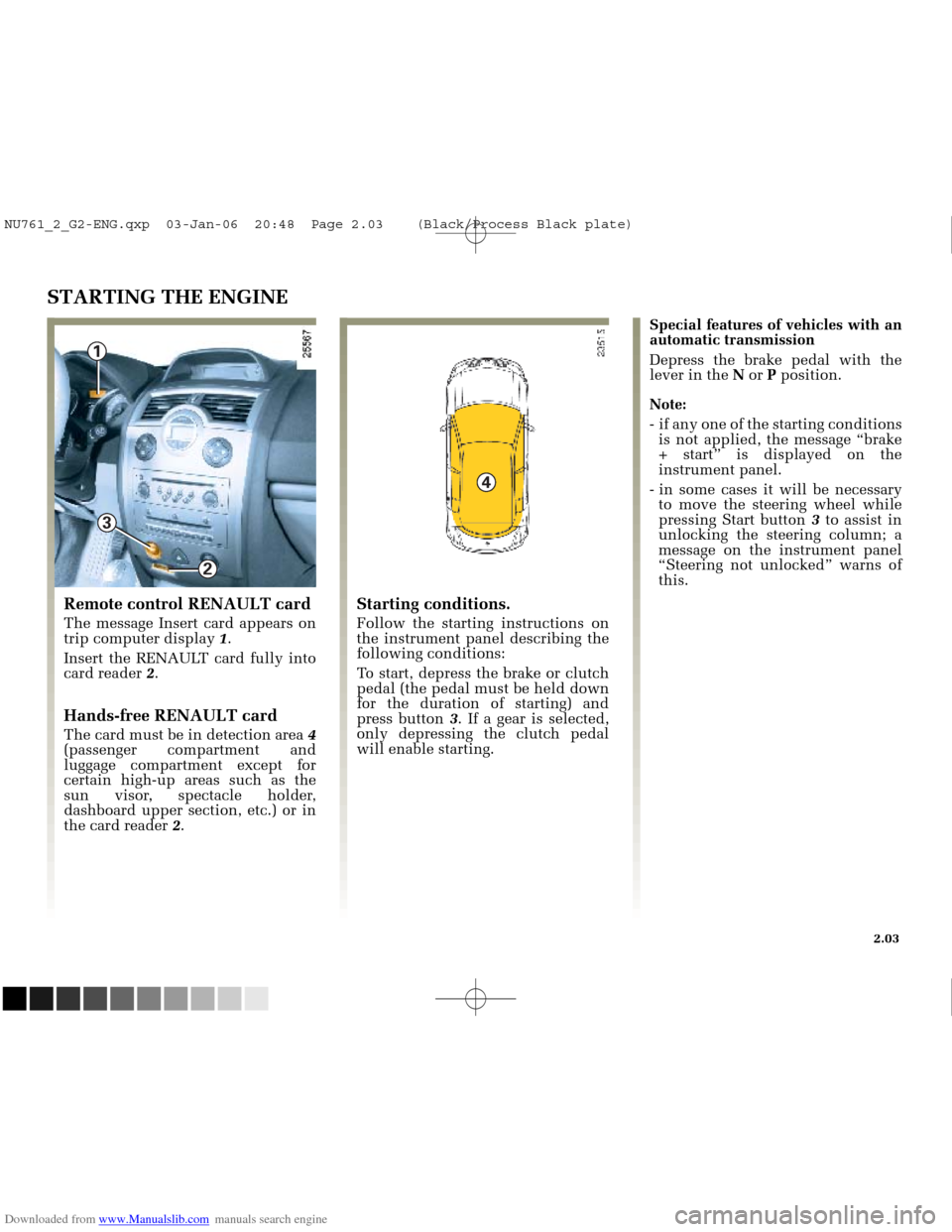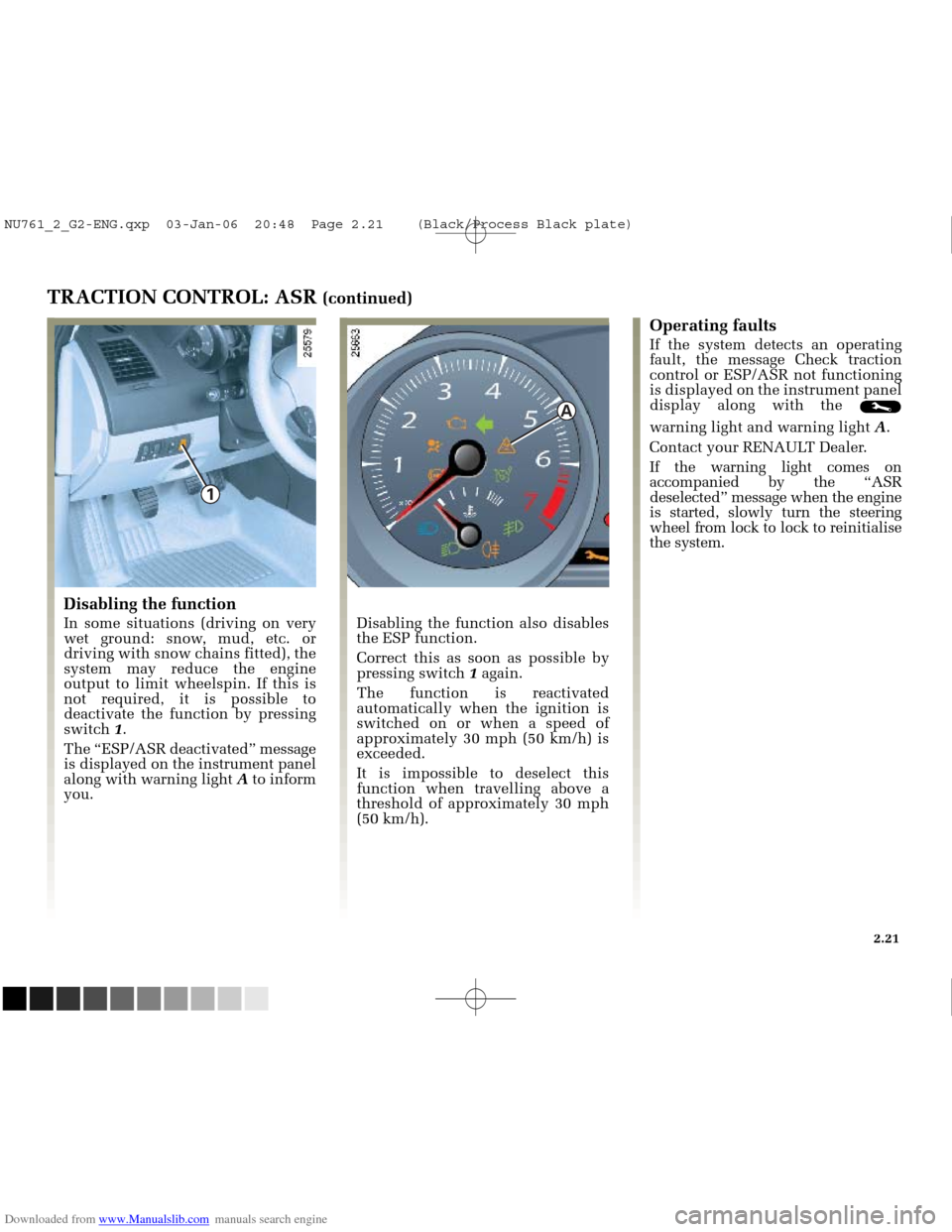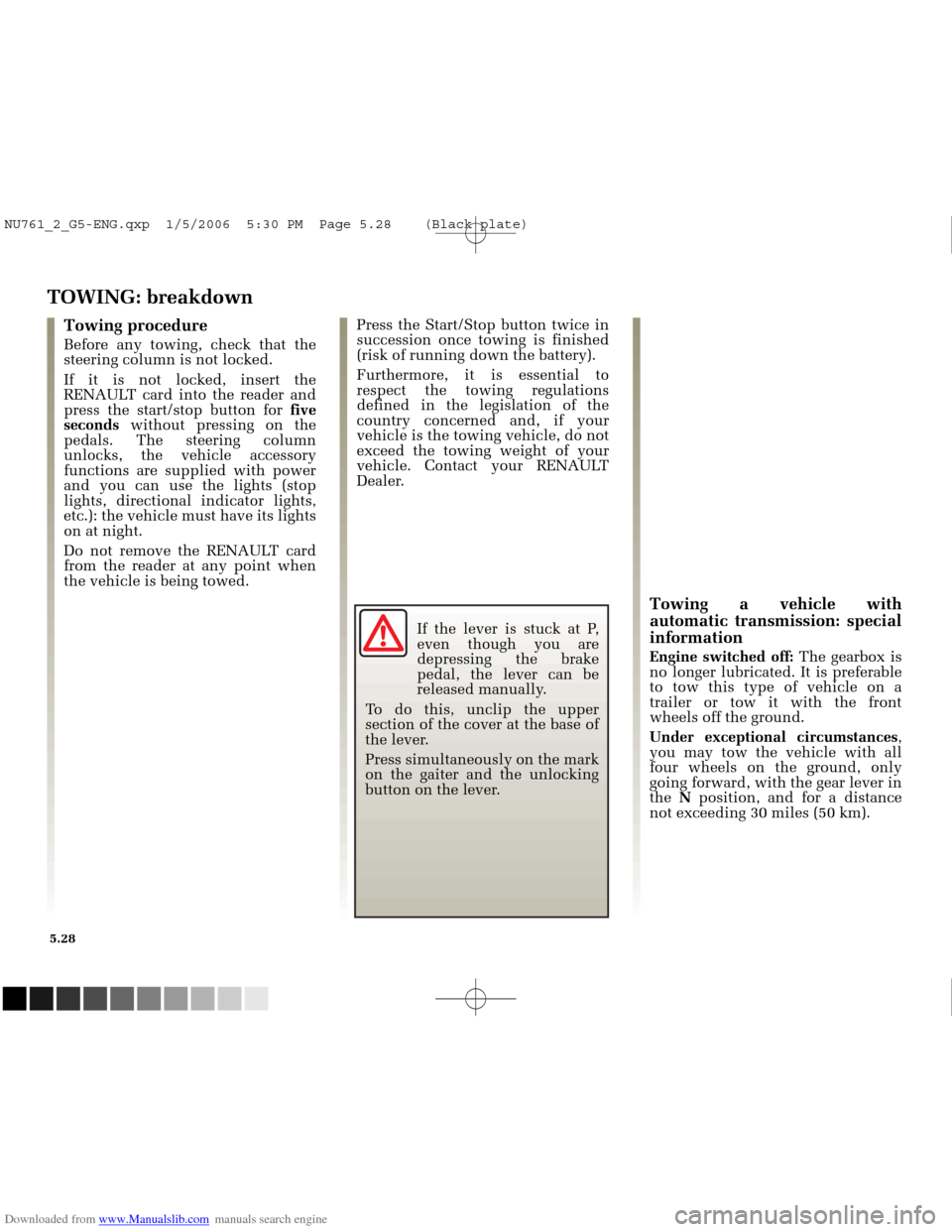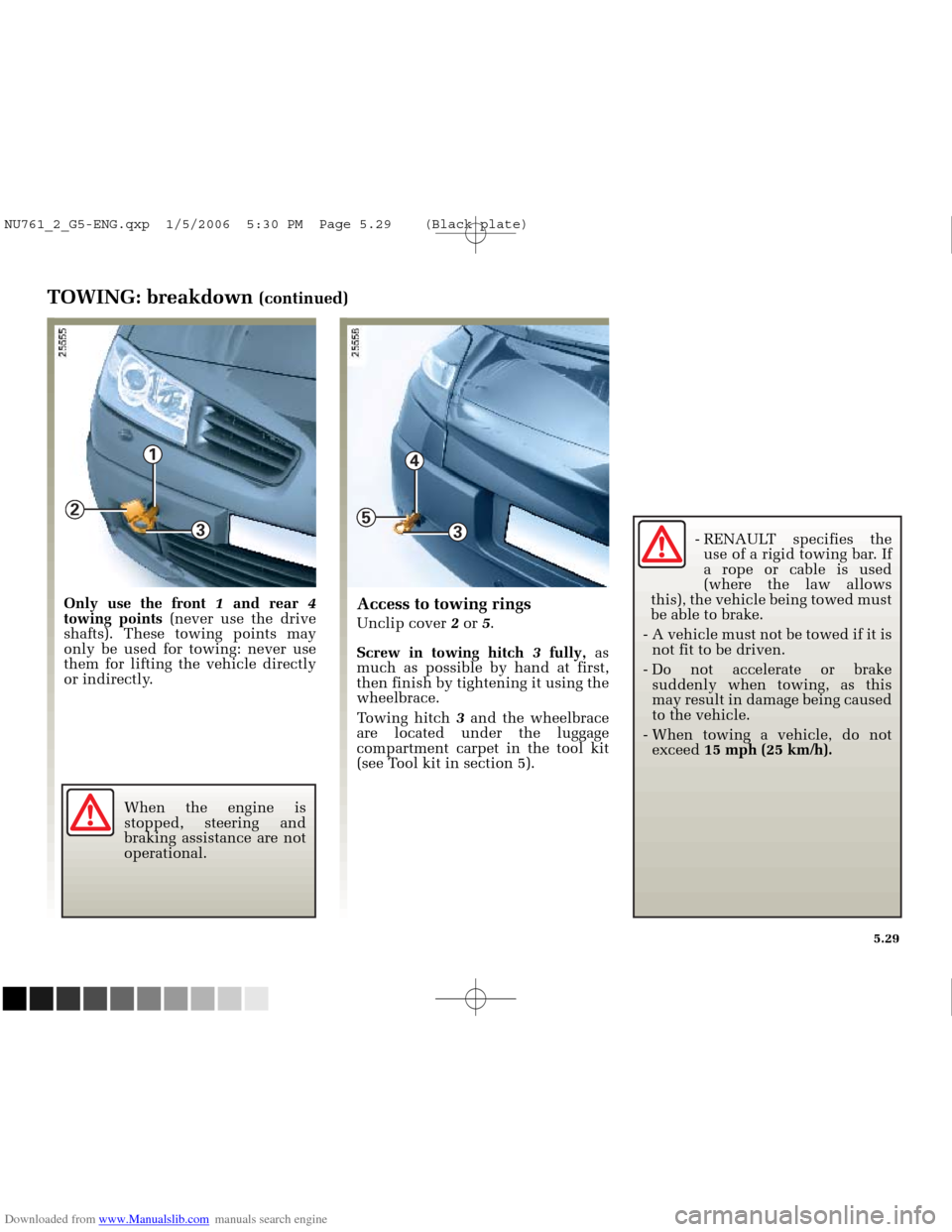2005 RENAULT MEGANE steering wheel
[x] Cancel search: steering wheelPage 91 of 250

Downloaded from www.Manualslib.com manuals search engine
1
2
0
NU761_2_G1-FRA.qxd 10/11/05 15:55 Page 1.81
1.81
THE HORN AND HAZARD LIGHTS
Horn
Press the steering wheel boss A.
Headlight flasher
Pull stalk 1towards you to flash the
headlights, even if the lights are not
in use.
Hazard warning lights éPress switch 2.
This switch illuminates all four
direction indicators and the side-
mounted indicators simultaneously.
Only use this function to warn other
road users if:
you are obliged to stop for any reason beyond your control in an
unusual or prohibited location,
you are obliged to drive under special conditions.
“Danger” Signal (continued)
Depending on the vehicle, the
hazard warning lights may come on
automatically under deliberate
heavy deceleration.
In this case, the hazard warning
lights may be switched off by
pressing switch 2once.
Direction indicators
Shift stalk 1parallel to the steering
wheel and in the direction you are
going to turn.
When driving on the motorway, the
steering wheel manoeuvres are
generally inadequate for automatically
bringing the stalk back to 0. There is an
intermediate position in which you
must keep the stalk during the
manoeuvre.
By releasing the stalk, it automatically
returns to 0.
NU761_2_G1-ENG.qxp 1/6/2006 12:23 PM Page 1.81 (Black plate)
Page 103 of 250

Downloaded from www.Manualslib.com manuals search engine
1
2
3
4
NU761_2_G2-FRA.qxd 4/11/05 10:48 Page 2.03
STARTING THE ENGINE
Special features of vehicles with an
automatic transmission
Depress the brake pedal with the
lever in the Nor Pposition.
Note:
- if any one of the starting conditions is not applied, the message “brake
+ start” is displayed on the
instrument panel.
- in some cases it will be necessary to move the steering wheel while
pressing Start button 3to assist in
unlocking the steering column; a
message on the instrument panel
“Steering not unlocked” warns of
this.
Remote control RENAULT card
The message Insert card appears on
trip computer display 1.
Insert the RENAULT card fully into
card reader 2.
Hands-free RENAULT card
The card must be in detection area 4
(passenger compartment and
luggage compartment except for
certain high-up areas such as the
sun visor, spectacle holder,
dashboard upper section, etc.) or in
the card reader 2.
Starting conditions.
Follow the starting instructions on
the instrument panel describing the
following conditions:
To start, depress the brake or clutch
pedal (the pedal must be held down
for the duration of starting) and
press button 3. If a gear is selected,
only depressing the clutch pedal
will enable starting.
2.03
NU761_2_G2-ENG.qxp 03-Jan-06 20:48 Page 2.03 (Black/Process Black\
plate)
Page 119 of 250

Downloaded from www.Manualslib.com manuals search engine
A
NU761_2_G2-FRA.qxd 4/11/05 10:48 Page 2.19
ELECTRONIC STABILITY PROGRAM: ESP WITH UNDERSTEER CONTROL
When the function begins to
operate, warning light Aflashes to
warn you.
If the warning light comes on
accompanied by the “ASR/ESP
deactivated” message when the
engine is started, slowly turn the
steering wheel from lock to lock to
reinitialise the system.
Understeer control
This system optimises the operation
of the ESP in the case of pronounced
understeering (loss of front axle
roadholding).
Operating faults
If the system detects an operating
fault, the message “Check traction
control” or “ESP/ASR not
functioning” is displayed on the
instrument panel display along with
indicator light and indicator
light A.
Contact your RENAULT Dealer.
This system helps to keep control of
the vehicle in critical driving
situations (avoiding an obstacle, loss
of grip when cornering, etc.) and
works in conjunction with the
understeer control system.
Operating principle
A sensor in the steering wheel
detects the direction selected by the
driver.
Other sensors throughout the vehicle
measure the actual direction.
The system compares the direction
selected by the driver and the actual
direction of the vehicle and corrects
this as necessary by applying the
brakes selectively and/or acting on
the engine power.
2.19
This function is an
additional aid in case of
critical driving conditions
to enable the vehicle
behaviour to be adapted to suit
the driving conditions.
However, the function does not
take the place of the driver. It
does not increase the vehicle’s
limits and should not encourage
you to drive more quickly.
Therefore, it can under no
circumstances replace the
vigilance or responsibility of the
driver when manoeuvring the
vehicle (the driver must always
be ready for sudden incidents
which may occur when driving).
NU761_2_G2-ENG.qxp 03-Jan-06 20:48 Page 2.19 (Black/Process Black\
plate)
Page 121 of 250

Downloaded from www.Manualslib.com manuals search engine
1
A
NU761_2_G2-FRA.qxd 4/11/05 10:48 Page 2.21
TRACTION CONTROL: ASR (continued)Operating faults
If the system detects an operating
fault, the message Check traction
control or ESP/ASR not functioning
is displayed on the instrument panel
display along with the
warning light and warning light A.
Contact your RENAULT Dealer.
If the warning light comes on
accompanied by the “ASR
deselected” message when the engine
is started, slowly turn the steering
wheel from lock to lock to reinitialise
the system.
Disabling the function also disables
the ESP function.
Correct this as soon as possible by
pressing switch 1again.
The function is reactivated
automatically when the ignition is
switched on or when a speed of
approximately 30 mph (50 km/h) is
exceeded.
It is impossible to deselect this
function when travelling above a
threshold of approximately 30 mph
(50 km/h).
Disabling the function
In some situations (driving on very
wet ground: snow, mud, etc. or
driving with snow chains fitted), the
system may reduce the engine
output to limit wheelspin. If this is
not required, it is possible to
deactivate the function by pressing
switch 1.
The “ESP/ASR deactivated” message
is displayed on the instrument panel
along with warning light Ato inform
you.
2.21
NU761_2_G2-ENG.qxp 03-Jan-06 20:48 Page 2.21 (Black/Process Black\
plate)
Page 195 of 250

Downloaded from www.Manualslib.com manuals search engine
NU761_2_G5-FRA.qxd 4/11/05 11:09 Page 5.07
5.07
TYRES (continued)
Pressures should be checked when
the tyres are cold; ignore higher
pressures which may be reached in
hot weather or following a fast
journey.
If the tyre pressures cannot be
checked when the tyres are cold,
assume an increase of 0.2 to 0.3 bar
(or 3 psi. ).
Never deflate a hot tyre.
Note: a label (depending on country
or model) fixed to the edge or frame
of the driver’s door gives the
recommended tyre pressures.
Changing wheels around
This practice is not recommended.
Tyre pressures
Tyre pressures must be adhered to,
tyre pressures for all wheels
(including the spare wheel) must be
checked at least once a month and
always before a long journey (refer
to the information on Tyre
pressures).
Emergency spare wheel
Refer to the information relating to
the emergency spare wheel and
changing a wheel in Section 5.
Fitting new tyres
Incorrect tyre pressures
lead to abnormal tyre
wear and unusually hot
running, factors which
may seriously affect safety and
lead to:
- poor roadholding,
- the risk of blow-outs or of throwing a tread at high speed.
The pressure depends on the load
and the speed of use. Adjust the
pressures according to the
conditions of use (refer to the
information on Tyre pressures). Vehicles equipped with
the tyre pressure monitor
Each of the sensors fitted
in the valves is dedicated
to one particular wheel: the
wheels must therefore not be
swapped around.
There is a risk of incorrect
information which could have
serious consequences. For safety reasons, this
operation must be carried
out by a specialist.
Fitting different tyres may
change your vehicle as follows:
- It may mean that your vehicle no longer conforms to current
regulations.
- It may change the way it handles when cornering.
- It may cause the steering to be heavy.
- It may cause tyre noise.
- It may affect the use of snow chains.
NU761_2_G5-ENG.qxp 1/5/2006 5:30 PM Page 5.07 (Black plate)
Page 206 of 250

Downloaded from www.Manualslib.com manuals search engine
1
3
2
1
2
NU761_2_G5-FRA.qxd 4/11/05 11:09 Page 5.18
5.18
FUSES
Fuse box 1
If electrical equipment does not
work, check the condition of the
fuses.
Open cover 2(underneath the
steering wheel or inside the glove
box).
To identify the fuses, refer to the
fuse allocation sticker (shown on the
following page).
In accordance with local
legislation or as a precautionary
measure:
Obtain an emergency kit of spare
bulbs and fuses from your
RENAULT Dealer.
Take out the fuse using tweezers 3,
located on the cover 2.
To remove the fuse from the
tweezers, slide the fuse to the side.
It is not advisable to use the free fuse
locations.
CORRECT INCORRECT
Check the fuse in question
and, if necessary, replace it
with a fuse of the same
rating.
If you fit a higher-amp fuse, it may
cause the electrical circuit to
overheat (risk of fire) in the event of
a consumer drawing an excessive
current.
NU761_2_G5-ENG.qxp 1/5/2006 5:30 PM Page 5.18 (Black plate)
Page 216 of 250

Downloaded from www.Manualslib.com manuals search engine
NU761_2_G5-FRA.qxd 4/11/05 11:10 Page 5.28
5.28
TOWING: breakdown
Press the Start/Stop button twice in
succession once towing is finished
(risk of running down the battery).
Furthermore, it is essential to
respect the towing regulations
defined in the legislation of the
country concerned and, if your
vehicle is the towing vehicle, do not
exceed the towing weight of your
vehicle. Contact your RENAULT
Dealer.Towing procedure
Before any towing, check that the
steering column is not locked.
If it is not locked, insert the
RENAULT card into the reader and
press the start/stop button for five
seconds without pressing on the
pedals. The steering column
unlocks, the vehicle accessory
functions are supplied with power
and you can use the lights (stop
lights, directional indicator lights,
etc.): the vehicle must have its lights
on at night.
Do not remove the RENAULT card
from the reader at any point when
the vehicle is being towed.
Towing a vehicle with
automatic transmission: special
information
Engine switched off: The gearbox is
no longer lubricated. It is preferable
to tow this type of vehicle on a
trailer or tow it with the front
wheels off the ground.
Under exceptional circumstances ,
you may tow the vehicle with all
four wheels on the ground, only
going forward, with the gear lever in
the N position, and for a distance
not exceeding 30 miles (50 km).
If the lever is stuck at P,
even though you are
depressing the brake
pedal, the lever can be
released manually.
To do this, unclip the upper
section of the cover at the base of
the lever.
Press simultaneously on the mark
on the gaiter and the unlocking
button on the lever.
NU761_2_G5-ENG.qxp 1/5/2006 5:30 PM Page 5.28 (Black plate)
Page 217 of 250

Downloaded from www.Manualslib.com manuals search engine
3
1
2
3
4
5
NU761_2_G5-FRA.qxd 4/11/05 11:10 Page 5.29
5.29
TOWING: breakdown (continued)
Only use the front 1and rear 4
towing points (never use the drive
shafts). These towing points may
only be used for towing: never use
them for lifting the vehicle directly
or indirectly.Access to towing rings
Unclip cover 2or 5.
Screw in towing hitch 3fully, as
much as possible by hand at first,
then finish by tightening it using the
wheelbrace.
Towing hitch 3and the wheelbrace
are located under the luggage
compartment carpet in the tool kit
(see Tool kit in section 5).
When the engine is
stopped, steering and
braking assistance are not
operational. - RENAULT specifies the
use of a rigid towing bar. If
a rope or cable is used
(where the law allows
this), the vehicle being towed must
be able to brake.
- A vehicle must not be towed if it is not fit to be driven.
- Do not accelerate or brake suddenly when towing, as this
may result in damage being caused
to the vehicle.
- When towing a vehicle, do not exceed 15 mph (25 km/h).
NU761_2_G5-ENG.qxp 1/5/2006 5:30 PM Page 5.29 (Black plate)